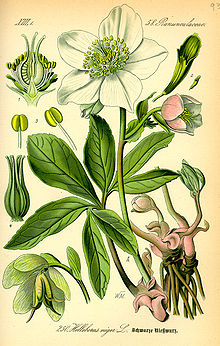Hellebore

Commonly known as hellebores (/ˈhɛlɪbɔːrz/), the Eurasian[2] genus Helleborus consists of approximately 20 species of herbaceous or evergreen perennial flowering plants in the family Ranunculaceae, within which it gave its name to the tribe of Helleboreae. Despite names such as “winter rose”,[3] “Christmas rose” and “Lenten rose”, hellebores are not closely related to the rose family (Rosaceae).[4] Many hellebore species are poisonous.
The genus was established by Carl Linnaeus in volume one of his Species Plantarum in 1753.[1]
The scientific name Helleborus could derive from the Ancient Greek word ἑλλέβορος (helléboros), the common name for H. orientalis, constructed from ἑλεῖν (heleîn, “to injure”) and βορά (borá), “food.”[5][6][7]. It is also possibly from Greek, ἄλκη “fawn”, βιβρώσκω (bibrṓskō, “to eat”).[8]
Hellebores are widely grown in USDA Zone 5a to 8b gardens for decorative purposes. They are particularly valued by gardeners for their winter and early spring flowering period; the plants are surprisingly frost-resistant and many are evergreen.[10] Also of value is their shade tolerance.[3] Many species of hellebore have green or greenish-purple flowers and are of limited garden value, although Corsican hellebore (H. argutifolius), a robust plant with pale green, cup-shaped flowers and attractive leathery foliage, is widely grown. So is the ‘stinking hellebore’ or setterwort (H. foetidus), which has drooping clusters of small, pale green, bell-shaped flowers, often edged with maroon, which contrasts with its dark evergreen foliage. H. foetidus ‘Wester Flisk’, with red-flushed flowers and flower stalks, is becoming popular, as are more recent selections with golden-yellow foliage.
The so-called Christmas rose (H. niger), a traditional cottage garden favourite, bears its pure white flowers (which often age to pink) in the depths of winter; large-flowered cultivars are available, as are pink-flowered and double-flowered selections.
The most popular hellebores for garden use are H. orientalis and its colourful hybrids, H. × hybridus (Lenten rose).. In the northern hemisphere, they flower in early spring, around the period of Lent, and are often known as Lenten hellebores, oriental hellebores, or Lenten roses. They are excellent for bringing early colour to shady herbaceous borders and areas between deciduous shrubs and under trees.
The cultivar Walberton’s Rosemary=’Walhero’ (sometimes listed under H. × hybridus) has won the Royal Horticultural Society’s Award of Garden Merit.[11]
